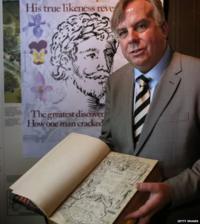 The portrait was engraved by William Rogers in 1597
The portrait was engraved by William Rogers in 1597A 400-year-old botany book contains what could be the only known portrait of Shakespeare made in his lifetime, according to an academic expert.
Botanist and historian Mark Griffiths cracked an "ingenious cipher" to identify the playwright in an engraving in the 16th-Century work.
"This is what Shakespeare looked like, drawn from life and in the prime of life," he said.
Details of his discovery are revealed in this week's issue of Country Life.
Mark Hedges, the magazine's editor, hailed it as "the literary discovery of the century".
Speaking at London's Rose Playhouse, he said the Shakespeare portrait was the "only known verifiable portrait of the world's greatest writer in his lifetime".
He added that the engraving showed the Bard aged 33 and "in his prime".
"He's written Midsummer Night's Dream and he's shortly to write Hamlet. He has a film star's good looks."
 Historian Mark Griffiths holds a copy of The Herball book
Historian Mark Griffiths holds a copy of The Herball bookIt is not the first time such claims have been made about a Shakespeare portrait.
In 2009, a painting known as the Cobbe portrait was put on show by the Shakespeare Birthplace Trust in Stratford-upon-Avon.
The trust said it was convinced the artwork - thought to date back to 1610 - was an authentic portrait, but some critics said the picture was not of Shakespeare.
Portraits 'decoded'
Griffiths made his discovery when he was researching the biography of pioneering botanist John Gerard (1545-1612), author of The Herball or Generall Historie of Plantes.
The 1,484 page book, published in 1598, is described as the largest single-volume work on plants that has been published in English.
Griffiths said on Tuesday that he was aware of only 10 surviving copies of the first edition that contained the title page with an engraving by William Rogers.
The four figures depicted in the engraving were assumed to have been imaginary.
However, Griffiths revealed he had decoded decorative devices around the figures - such as heraldic motifs and emblematic flowers - to reveal their "true identities".
They are the author Gerard, Rembert Dodoens, a renowned Flemish botanist, and Queen Elizabeth's Lord Treasurer, Lord Burghley.
The fourth man holds a fritillary and an ear of sweetcorn - plants which Griffiths says point to Shakespeare's poem Venus and Adonis and his play Titus Andronicus.
Below the bearded fourth man - who wears a laurel wreath - was "an ingenious cipher of the kind loved by the Elizabethan aristocracy" which, when decoded, confirmed his identity as "William Shakespeare".
Edward Wilson, emeritus fellow of Worcester College, Oxford, explained said that he and Griffiths had spent five years consulting Latin and Shakespeare scholars before going public.
"We do not think anyone is going to dispute this at all," he said.
Griffiths writes in Country Life: "The Fourth Man is not cartoonish or stylised. It may be monochrome, in fancy dress, and just 3.5 inches tall, but this is something that has been sought for centuries."
He goes on: "By the time that portraits of Shakespeare were at a premium, the significance of the Rogers engraving had faded from memory. Its camouflaged figures, coded plants and ciphers proved too clever for its own good.
"The title page, one of the richest and most important artworks of the English Renaissance, came to be seen merely as a bibliophile's rarity and a fine, if stereotypical specimen of Elizabethan decoration. Nobody dreamed of finding Shakespeare in it."
Professor Michael Dobson, director of the Shakespeare Institute at the University of Birmingham, said he was "deeply unconvinced" by the theory.
"I haven't seen the detailed arguments but Country Life is certainly not the first publication to make this sort of claim," he said.
"One has seen so many claims on Shakespeare based on somebody claiming to crack a code. And nobody else has apparently been able to decipher this for 400 years.
"And there's no evidence that anybody thought that this was Shakespeare at the time."
(Source by: BBC NEWS )
No comments:
Post a Comment